Sabrent Rocket DDR5-4800 Review: The O/C Is Real!
Sabrent is ready to take on established brands in the DRAM market, and those who don’t believe this should ask themselves when was the last time they heard the word Sabrent used outside of the storage market. You’ll probably need the Wayback Machine just to remind yourself that this was little more than a peripherals brand a mere three years ago: Sabrent is moving fast!
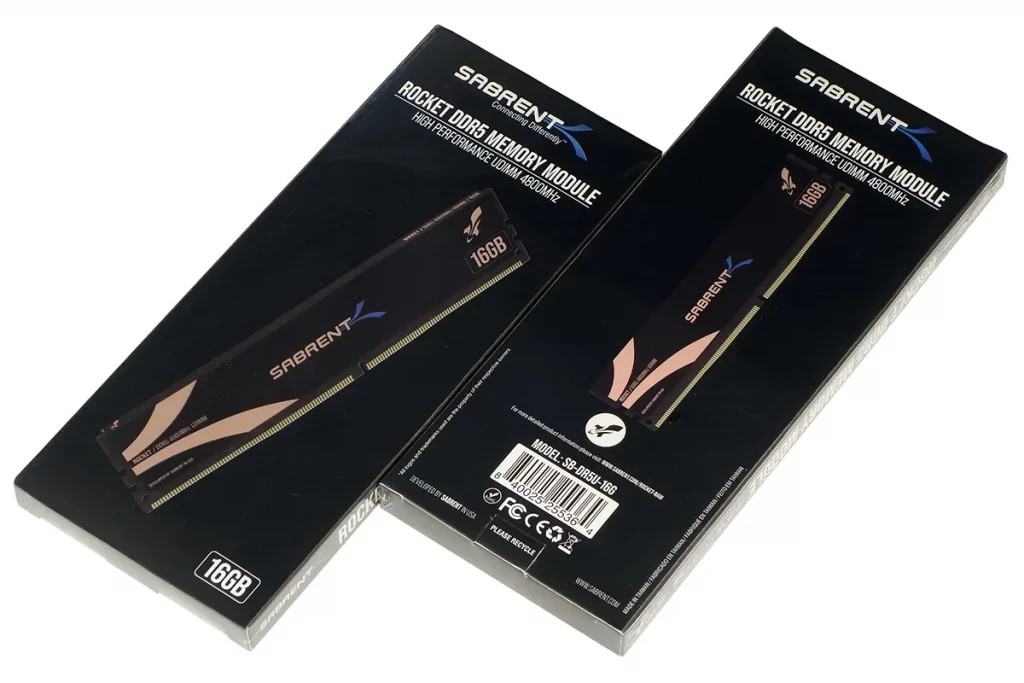
As a new player in the DRAM market, Sabrent’s desktop line focuses entirely on a single part, the H5CG48MEBD-X014 IC from Hynix. From that IC Sabrent gets two different modules, one with two active sides (32GB) and one with a single active side (16GB) as shown.

Get it at Amazon

(click for availability)
You’ll have to order two if you’d like a pair, so the firm sent us two of its SB-DR5U-16G 16GB modules.

By now you’re probably noticing that the heat spreaders look more like stickers than sinks, and that’s because they’re made from metallic sheet that, at just over 0.2mm thick, barely qualifies as thicker than foil. Folded around the top of the module and using an adhesive backing for retention, an elastic tendency to unfold prevents these from laying completely flat.
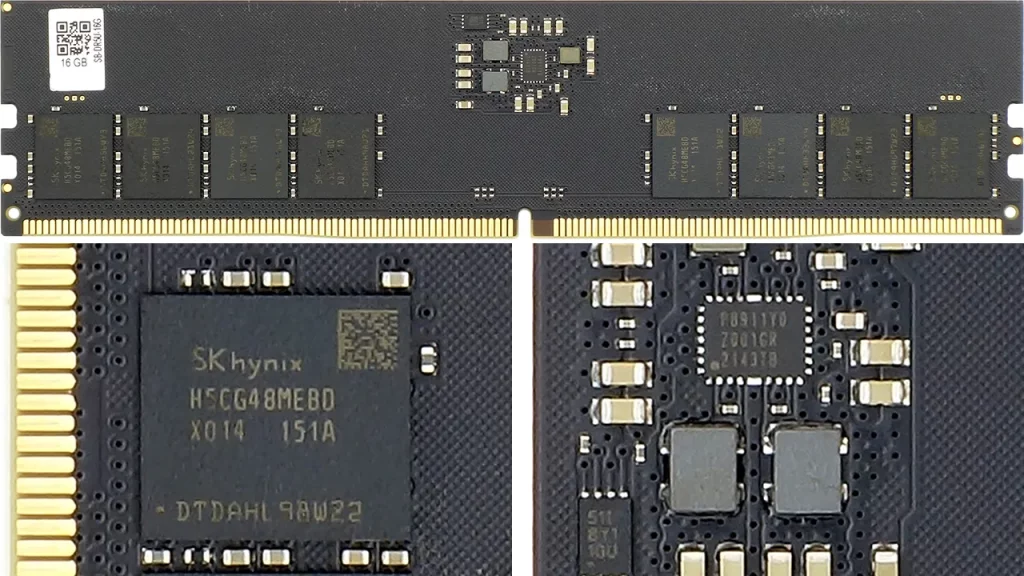
Peeling the metallic thicker-sticker reveals the before mentioned Hynix ICs for which Sabrent Rocket DDR5 has earned so many overclocking accolades, along with the Renesas P8911 that gives it the stable, adjustable voltage needed to reach those bandwidth heights.
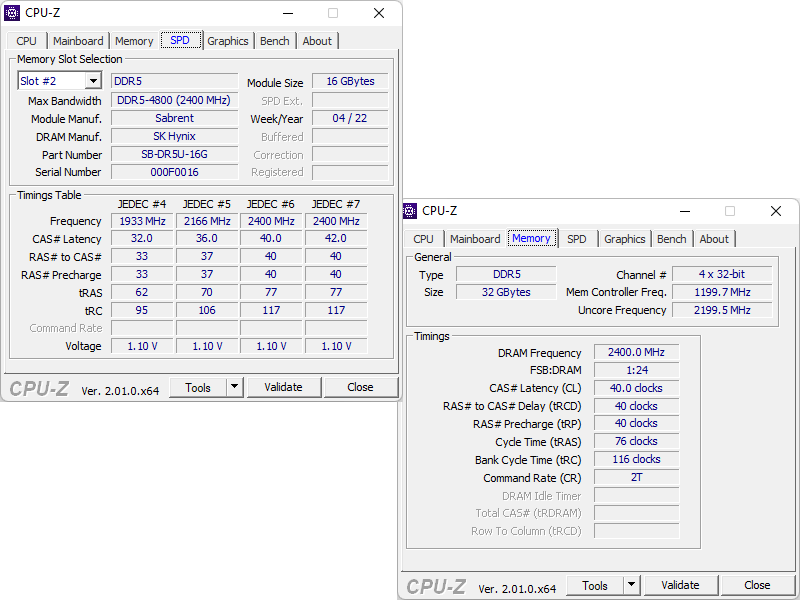
Rated at DDR5-4800 C40 and programmed as such without XMP, pricing is the only problem with this rating. Our previously-reviewed Crucial DDR5-4800 currently costs around $100 less than a pair of Sabrent Rocket DDR5-4800 modules for example, leaving us to determine whether Rocket’s extra overclocking headroom can make up for its added cost.
| Test Hardware | |
| CPU | Intel Core i9-12900KF: 16C/24T, 3.2-5.2 GHz, 30 MB L3 Cache, LGA 1700 |
| CPU Cooler | Alphacool Eisblock XPX CPU, VPP655 with Eisbecher D5 150mm, NexXxoS UT60 X-Flow |
| Motherboard | ASRock Z690 Extreme WiFi 6E LGA 1700 |
| Graphics | Gigabyte GeForce RTX 2070 Gaming OC 8G: 1410-1725 MHz GPU, GDDR6 |
| Power | be quiet! Dark Power Pro 10 850W: ATX12V v2.3, EPS12V, 80 PLUS Platinum |
| Hard Drive | TOSHIBA OCZ RD400 256GB NVMe 1.1b SSD |
| Sound | Integrated HD Audio |
| Network | Integrated Wi-Fi |
| Graphics Driver | GeForce 496.49 |
To keep our benchmark data comparable between tests of similar hardware, we’re trying to retain our original driver set until a new platform launches.
Overclocking & Latency Optimization
A funny thing happened on our way to an overclocking record: The “heat spreader” on one module came unstuck in the center, giving the module a pocket of trapped air where the center ICs (including the voltage controller) were supposed to be touching it. We eventually got the heat spreader to stick at voltage levels up to 1.35V, which just happens to be the same voltage that our Patriot Viper Venom needed to reach the same DDR5-6400 frequency.
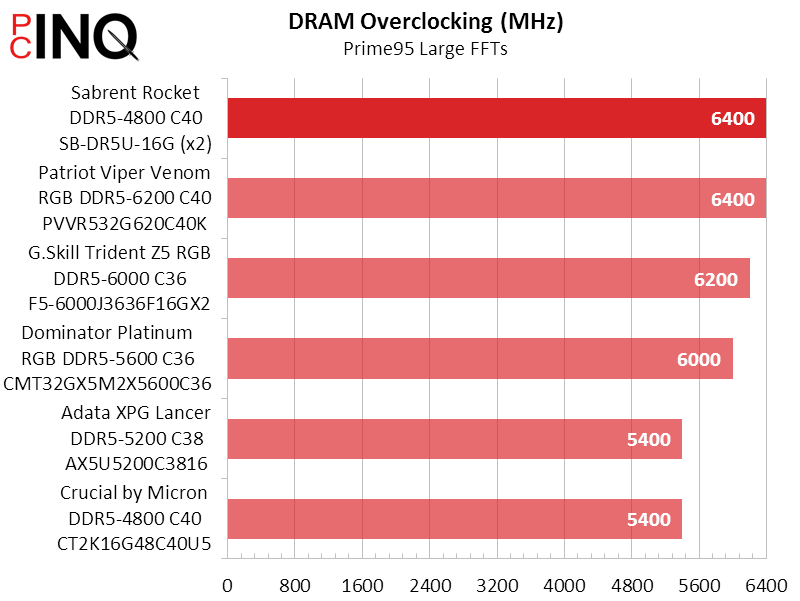
Even though the Rocket held onto our “next quicker setting” a bit longer before crashing, our efforts to reduce latency eventually ended up in the same place for the Rocket 4800 as the Viper Venon 6200. The likely reason is that both kits use the same Hynix H5CG48MEBD-X014 ICs.
| Lowest Stable Timings | |||
| DDR5-6400 | DDR5-5600 | DDR5-4800 | |
| Sabrent Rocket DDR5-4800 C40 |
38-38-38-76 (2T) | 33-33-33-66 (2T) | 29-29-29-58 (2T) |
| Patriot Viper Venom RGB DDR5-6200 C40 |
38-38-38-76 (2T) | 33-33-33-66 (2T) | 29-29-29-58 (2T) |
| G.Skill Trident Z5 RGB DDR5-6000 C36 |
X | 31-31-31-62 (2T) | 28-28-28-56 (2T) |
| Dominator Platinum RGB DDR5-5600 C36 |
X | 34-34-34-68 (2T) | 28-28-28-56 (2T) |
| Adata XPG Lancer DDR5-5200 C38 |
X | X | 36-36-36-72 (2T) |
| Crucial DDR5-4800 C40 | X | X | 36-36-36-72 (2T) |
Benchmark Results
Since DDR5-6400 is the both the highest frequency that we optimize timings for and the highest frequency we reached with the Rocket DDR5-4800, we applied the same 6400C38 data to both Max O/C and Min CAS boxes of the Sabrent kit. Note that the label “XMP” in our chart refers to each kits rated data rate and timings so that even though Sabrent Rocket has no XMP, the numbers within that color code still use its rated settings.






Though manually tuned Rocket DDR5 often outperforms Viper Venom in bandwidth and latency tests, its baseline values occasionally lose to the far-cheaper Crucial kit. Buyers really need to know what they’re doing (and why) in order to make sense of their Rocket DDR5 purchase.


3DMark’s CPU score repeats the performance trend seen in memory benchmarks, but any advantages in those artificial scenarios fail to emerge in our real-world game test.




All of our real-world working benchmarks appear to favor overclocked Rocket DDR5 slightly, but how close are these results when averaged?
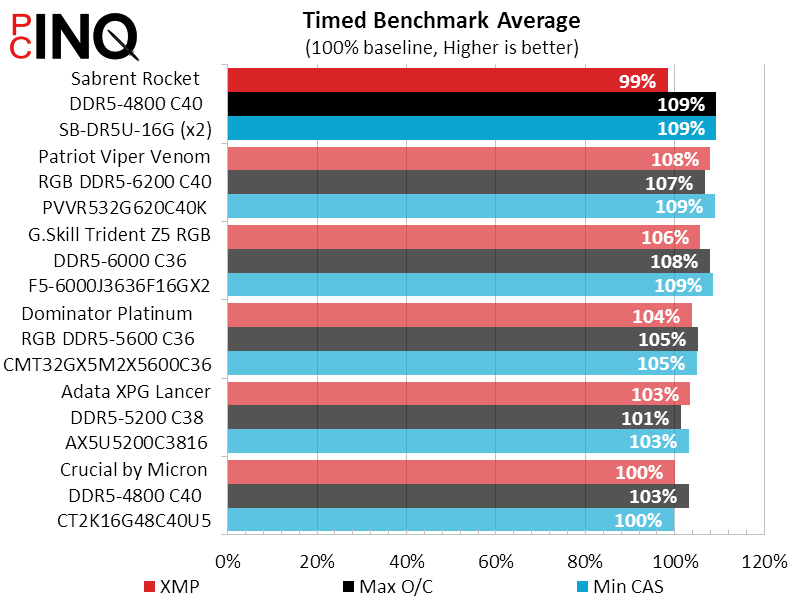
Our top three configurations reached a performance average of 9% better than our DDR5-4800 C40 baseline. That three way tie came at DDR5-6400 for the Sabrent Rocket and Patriot Viper Venom, and DDR5-5600 C31 for the G.Skill Trident Z5.
With the same performance advancement in play, price could be the easiest way to determine a winner. Unfortunately, Sabrent Rocket is not the cheapest of the three, despite its lower rated frequency and cheaper skins. That honor instead goes to a kit that has the same Hynix memory chips, plus a higher XMP and additional aesthetic features, Patriot’s Viper Venom RGB DDR5-6200. Given that finding, we’ll step out on a limb to say that if a newcomer really wants to overtake its competitors…it should consider what those competitors are charging for significantly similar items.
| Sabrent Rocket DDR5-4800 C40 | |
| Pros | Cons |
|
|
| The Verdict | |
| Overclocking capability is nice, but manufacturers should only charge for the performance they’re willing to certify. Rocket DDR5-4800 comes with no such certification, nor any XMP to support it. | |
Get it at Amazon

(click for availability)
Speaking of things that companies can self-certify, the Sabrent warranty page is still written in the style of a peripheral brand. As the warrantee isn’t outlined anywhere else, that lack of individualized information will surely leave potential buyers as confused as we were.
